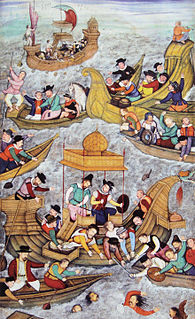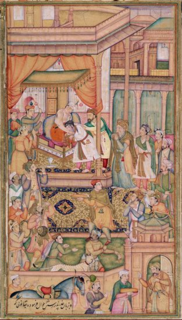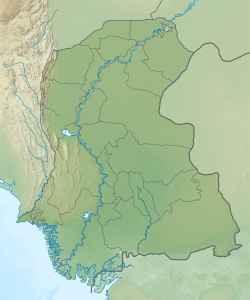
A sandbag or dirtbag is a bag or sack made of hessian (burlap), polypropylene or other sturdy materials that is filled with sand or soil and used for such purposes as flood control, military fortification in trenches and bunkers, shielding glass windows in war zones, ballast, counterweight, and in other applications requiring mobile fortification, such as adding improvised additional protection to armored vehicles or tanks.

Qutb-ud-Din Bahadur Shah, born Bahadur Khan was a sultan of the Muzaffarid dynasty who reigned over the Gujarat Sultanate, a late medieval kingdom in India from 1526 to 1535 and again from 1536 to 1537. He ascended to throne after competing with his brothers. He expanded his kingdom and made expeditions to help neighbouring kingdoms. In 1532, Gujarat came under attack of the Mughal Emperor Humayun and fell. Bahadur Shah regained the kingdom in 1536 but he was killed by the Portuguese on board a ship when making a deal with them.

Muhammad Bairam Khan, commonly known as Bairam Khan or Bayram Khan was an important military commander, and later commander-in-chief of the Mughal army, a powerful statesman and regent at the court of the Mughal Emperors, Humayun and Akbar. He was also the guardian, chief mentor, adviser, teacher and the most trusted ally of Akbar. Akbar honoured him as Khan-i-Khanan, which means "King of Kings". Bairam was originally called Bairam "Beg", but later became honoured as 'Kha' or Khan. Bairam Khan was an aggressive general who was determined to restore Mughal authority in India. Two divans are attributed to him, one in Persian and the other in Chagatai.

The Arghun Dynasty was a dynasty of either Mongol, Turkic or Turco-Mongol ethnicity, who ruled over the area between Southern Afghanistan and Sindh from the late 15th century to the early 16th century. The Arghuns claimed their descent and name from Ilkhanid-Mongol Arghun Khan. Arghun rule can be divided into two branches: the Arghun branch of Dhu'l-Nun Beg Arghun that ruled until 1554, and the Tarkhan branch of Muhammad 'Isa Tarkhan that ruled until 1591.
Badin is the main city and capital of Badin District in Sindh, Pakistan. It lies east of the Indus River. It is the 87th largest city in Pakistan. Badin is often called 'Sugar State' due to its production of sugar.

Thatta District is located in the southern area, locally called Laar, of the province of Sindh, Pakistan. Its capital is Thatta. It is home to a large necropolis of Makli. In 2013, several talukas were separated to form the new Sujawal District.
Balapur is a city and a municipal council in Akola district in the state of Maharashtra, India.
The Berar Subah was one of the Subahs of the Mughal Empire, the first to be added to the original twelve, in Dakhin from 1596 to 1724. It bordered Golconda, Ahmandagar, Kandesh and Malwa subahs as well as the independent and tributary chiefdoms to the east.

Mahabat Khan, born Zamana Beg, was a prominent Mughal general and statesman, perhaps best known for his coup against the Mughal Emperor Jahangir in 1626. He also served Subahdar of Malwa Subah from 1611 to 1623 and Bengal Subah during 1625–1626. He earned the title Khan-i-Khanan from emperor Shah Jahan.

Naserpur, or Nasarpur, is a small town in Sindh, Pakistan.
Agham Kot, historically known as Agham and today also called Aghamani or Aghamano, is a historical city and present-day ruin site located in Badin District, Sindh, Pakistan. It is located about 1.5 km northwest of the current town of Ghulab Khan Laghari, near the border with Hyderabad District. Said to be named after its 7th-century founder, the Lohana king Agham Lohana, Agham Kot historically lay on the right bank of the Dhoro, a branch of the Indus River that is now dried up. Because of this strategic location on an important waterway, Agham Kot was an important commercial centre in its heyday.
Badi' al-Zaman Mirza was a Timurid ruler of Herat from 1506 to 1507. He was the son of Husayn Bayqarah, who was a great-great-grandson of Timur.
Sann is a small town and union council located in Manjhand taluka of Jamshoro District, Sindh Province, Pakistan. It lies on the western bank of the Indus river, at the mouth of an intermittent stream that brings down water from the Lakhi hills when it rains. The town is located midway between Manjhand and Amri on the main Sehwan-Kotri trunk road.
In 1573, Mughal Emperor Akbar conquered Gujarat Sultanate taking advantage of young Gujarat Sultan Muzaffar Shah III and his quarrelling nobles. Muzaffar was held captive at Agra. He appointed his foster brother Mírza Âzíz Kokaltásh as the first viceroy who faced an insurrection by the rebel nobles of the former Sultanate. Akbar quickly came to aid and ended the insurrection. He soon appointed Mírza Khán who managed to set revenue system and quelled attack by the Mirzas with help of Mughal minister Todar Mal. The next viceroy Shaháb-ud-dín strengthened the military. Soon Sultan Muzaffar escaped, returned to Gujarat and led an attack on Ahmedabad and recaptured it before his former noble and now viceroy Itimad Khan reach the city. Soon Mirza Khan was reappointed as the viceroy who defeated Muzaffar in the battle of Fatehwadi in 1584. Soon Kokaltásh returned as the viceroy and defeated Muzaffar and combined Kathiawad forces in battle of Bhuchar Mori. Later Muzaffar was captured but he committed suicide, putting an end to the Gujarat Sultanate. As Kokaltásh went to the Mecca on pilgrimage, Sultan Murad Bakhsh was appointed as the viceroy on whose death, Kokaltásh returned third time as the viceroy. Akbar was succeeded by Jehangir.

Mirak Bahadur Jalair was a Mughal officer during the reign of Emperor Jahangir. He served as the chief sardar of Sylhet Sarkar from 1617 to 1620.
Talti is a town and union council in Sehwan taluka of Jamshoro District, Sindh. It is located in the historical pargana of Baghban, 8 miles north of Sehwan and 2 miles off the main road from Sehwan to Larkano. It also has road connections with nearby Bhan and Bubak. There is a dhandh near Talti that is used as a source of fishery.
Bubak is a town and union council in Sehwan taluka of Jamshoro District, Sindh. It is located on the northeastern shore of Lake Manchar, 9 miles west of Sehwan. Besides Sehwan, it is connected by road with Bhan and Talti.
Kakrala was a historical region in southern Sindh, in the coastal parts of the Indus Delta. Descriptions of its precise extent vary, but it lay in the middle part of the delta, comprising the present-day taluqas of Shahbandar and Jati in Sujawal and Thatta districts. It has been described as the region from Jati to Kharo Chan, or the region between the mouths of the Wanyani and Pitti rivers. This area later formed part of the pargana of Ghorabari.
Chandūka, also spelled Chāndkoh or Chāndko, was a historical region in Sindh, roughly corresponding to the Larkana subdivision as it existed in the early 20th century. It was an alluvial tract on the right bank of the Indus with its main town at Ghaibi Dero. S.H. Hodivala also wrote in 1939 that Chanduka was then the name of the main town in Larkana District. Chanduka is named after the Baluch tribe known as the Chandias.

Shaykh ʿAbdul Wāḥid was a military general of the Mughal Empire during the reign of Jahangir, and played an important role in defeating Bahadur Ghazi, who was among the rebellious Baro-Bhuiyans of Bengal. He is celebrated as the Mughal conqueror of Bhulua as he was the chief commander of its expedition. His administration of the Bhulua frontier involved suppressing multiple Arakanese invasions, later earning him the title of Sarḥad Khān.










